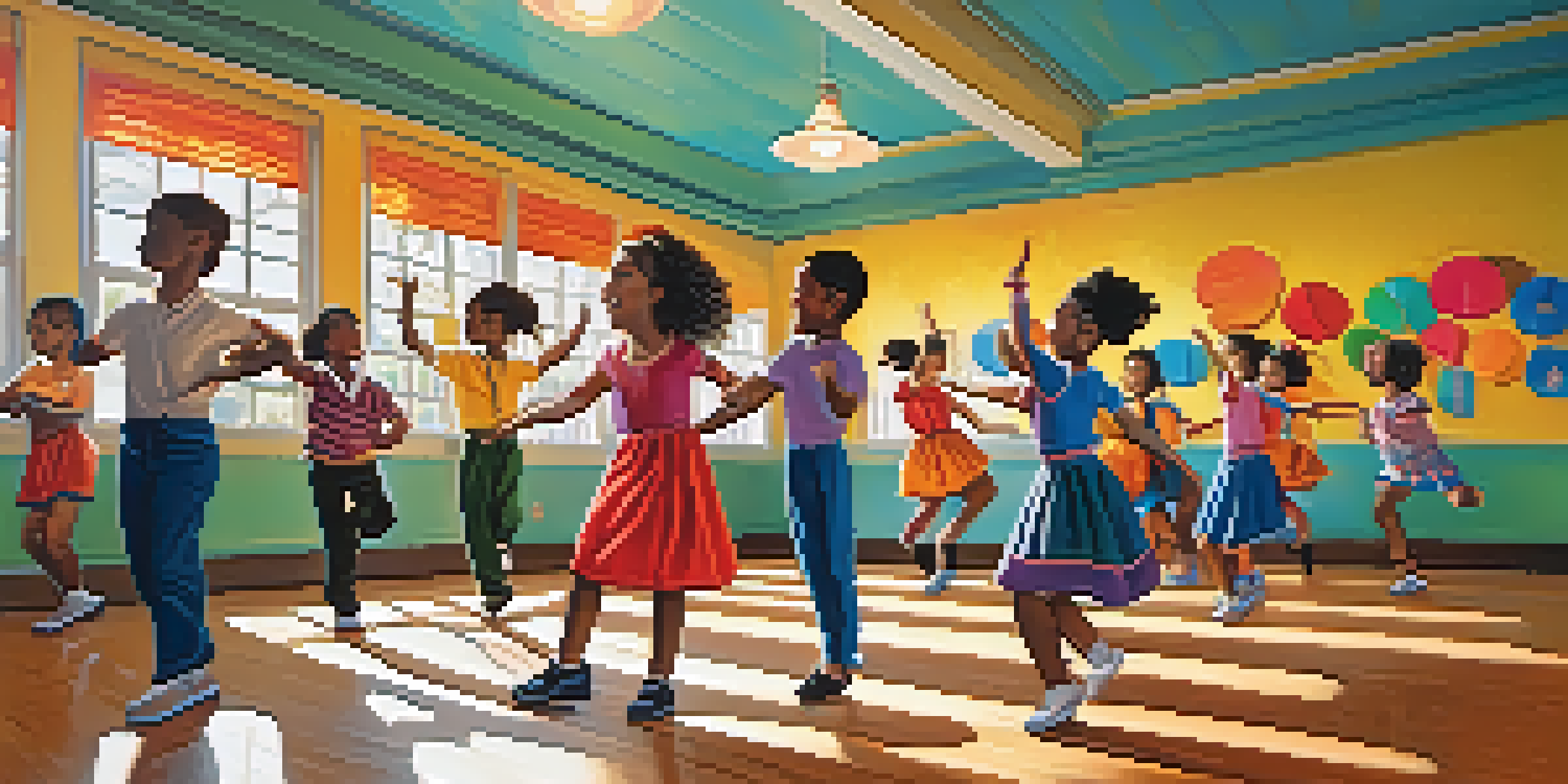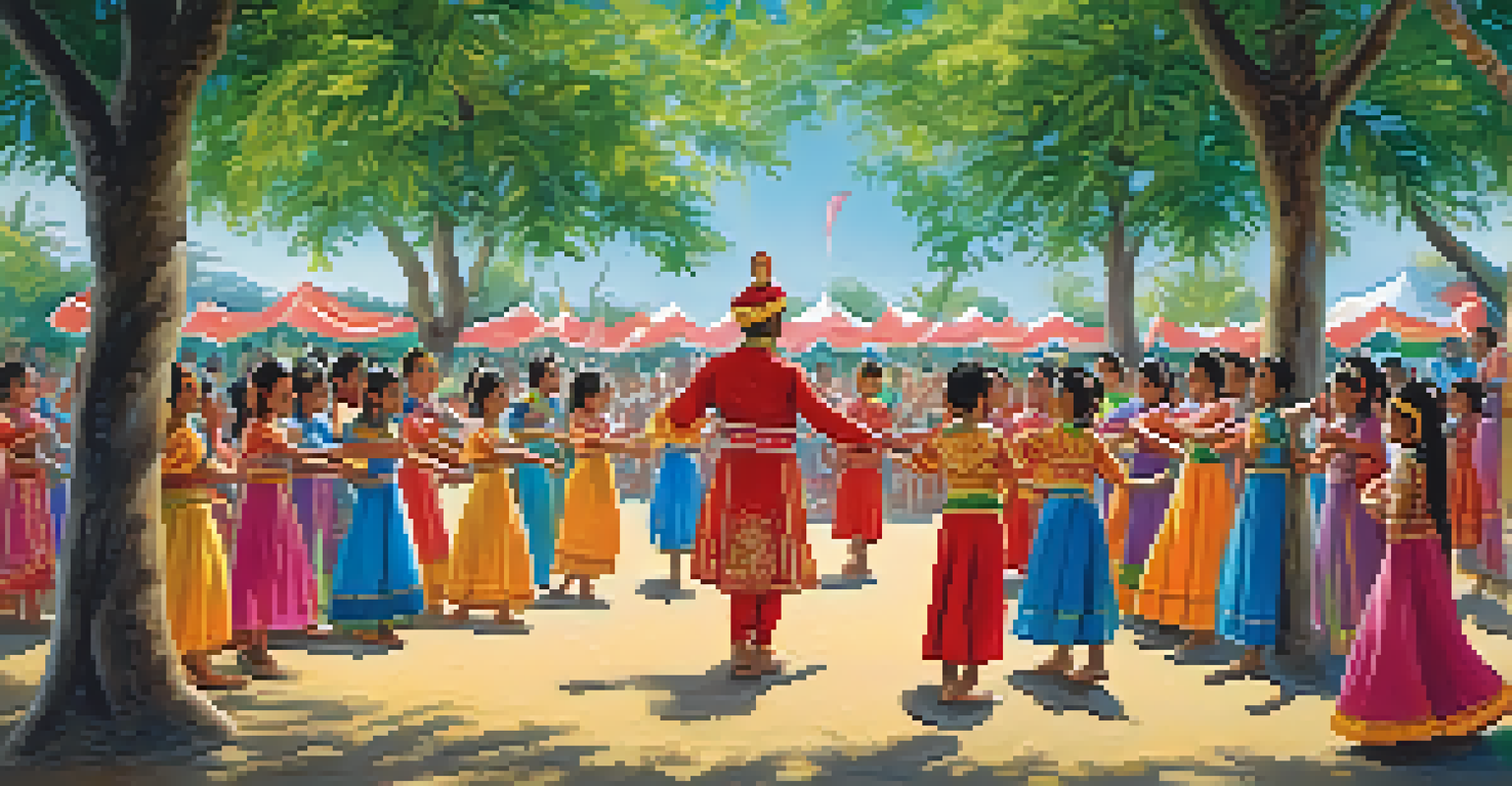Dance as a Medium for Cultural Education in Schools

The Importance of Cultural Education in Schools
Cultural education plays a vital role in shaping students' identities and worldviews. It provides them with a better understanding of their own backgrounds and those of others. By learning about different cultures, students can develop empathy and appreciation for diversity, which is crucial in our increasingly interconnected world.
Dance is the hidden language of the soul.
Incorporating cultural education into the curriculum helps foster a sense of belonging and community among students. It encourages them to share their experiences and learn from one another. This exchange of ideas creates a richer learning environment where everyone feels valued and respected.
Ultimately, cultural education prepares students to become informed and engaged global citizens. It equips them with the skills needed to navigate the complexities of a multicultural society, promoting tolerance and inclusivity in all aspects of their lives.
Dance: A Universal Language of Expression
Dance is often referred to as a universal language, transcending cultural and linguistic barriers. It allows individuals to express their emotions and stories in a way that words sometimes cannot. This form of expression can be particularly powerful in an educational setting, where students may struggle to articulate their thoughts.

Through dance, students can explore their own cultural heritage while also learning about others. Traditional dances from various cultures serve as a window into the history, values, and beliefs of those communities. This exploration not only enriches students' understanding but also encourages them to celebrate diversity in their own lives.
Cultural Education Shapes Identity
Cultural education fosters empathy and understanding, helping students appreciate diversity in our interconnected world.
Moreover, dance encourages collaboration and teamwork, as students often perform in groups. This communal aspect helps students build relationships and strengthen social bonds, making the classroom a more dynamic and inclusive space for all.
Integrating Dance into the Curriculum
Integrating dance into school curricula can be achieved in various ways, from dedicated dance classes to interdisciplinary projects. For example, a history lesson can be enhanced by incorporating traditional dances from that era or region. This not only makes the lesson more engaging but also allows students to physically connect with the material.
Education is the most powerful weapon which you can use to change the world.
Teachers can also collaborate with local dance organizations to provide workshops and performances, bringing real-world experiences into the classroom. This collaboration can spark interest and inspire students to delve deeper into their cultural studies. It also reinforces the idea that learning extends beyond textbooks and classrooms.
As schools embrace a more holistic approach to education, incorporating dance as a medium for cultural education becomes increasingly relevant. By doing so, educators can create well-rounded curricula that cater to diverse learning styles and promote cultural appreciation.
Benefits of Dance for Students' Wellbeing
In addition to its educational benefits, dance offers numerous advantages for students' physical and mental wellbeing. Engaging in dance helps improve physical health, coordination, and fitness levels. This is especially important in a time when sedentary lifestyles are becoming more common among young people.
Moreover, dance serves as a creative outlet for self-expression, providing students with a healthy way to process their emotions. It encourages them to channel their feelings into movement, which can reduce stress and anxiety. This emotional release can be particularly beneficial during challenging times.
Dance Enhances Learning and Wellbeing
Integrating dance into the curriculum promotes physical health, emotional expression, and social bonding among students.
Additionally, participating in dance can boost students' confidence and self-esteem. As they learn new skills and perform in front of peers, they develop a sense of accomplishment and pride in their abilities. This transformation can positively impact their overall attitude towards learning and school.
Cultural Exchange Through Dance Programs
Dance programs that promote cultural exchange offer students the chance to learn from one another in a unique and engaging way. These programs can involve partnerships with schools from different cultural backgrounds, allowing students to share their traditional dances and learn new ones. This exchange fosters mutual respect and understanding among diverse student populations.
In addition, cultural exchange through dance can lead to the creation of new dance styles that blend elements from various traditions. This fusion not only enriches students' artistic experiences but also highlights the beauty of cultural collaboration and innovation. It provides a platform for students to showcase their creativity while honoring their roots.
Ultimately, these programs contribute to a sense of global citizenship, as students learn to appreciate and celebrate cultural diversity. By participating in cultural exchange through dance, students gain valuable insights into the world around them, preparing them for a future that values inclusivity and collaboration.
The Role of Teachers in Promoting Dance Education
Teachers play a crucial role in promoting dance education and its cultural significance. By integrating dance into their lesson plans, they can create a vibrant learning environment that encourages exploration and creativity. Educators who are passionate about dance can inspire students to appreciate this art form and its capacity to communicate culture.
Additionally, teachers can provide students with the necessary context and history behind various dance styles. This knowledge enhances students' understanding of the cultural significance of dance, making their learning experience richer and more meaningful. When teachers share their own experiences and insights, students are more likely to engage and connect with the material.
Collaboration Boosts Dance Programs
Partnerships with community organizations can enhance dance education, overcoming budget constraints and resource limitations.
Furthermore, teachers can advocate for resources and opportunities for students to experience dance outside the classroom. Whether through field trips to performances or partnerships with local dance schools, these experiences can deepen students' appreciation for dance and its cultural importance.
Challenges and Solutions in Implementing Dance Programs
While the benefits of incorporating dance into cultural education are clear, there are challenges that schools may face in implementing these programs. Budget constraints can limit access to quality dance instruction and resources, making it difficult for schools to offer comprehensive dance education. Additionally, some educators may feel unprepared to teach dance effectively.
To overcome these challenges, schools can seek partnerships with community organizations, dance studios, and local artists. These collaborations can provide valuable resources and expertise, helping to enhance the dance curriculum without straining school budgets. Furthermore, professional development opportunities for teachers can equip them with the skills and confidence needed to teach dance.

Ultimately, addressing these challenges requires a collaborative effort among educators, administrators, and the community. By working together, schools can create sustainable dance programs that enrich cultural education and benefit students' overall development.